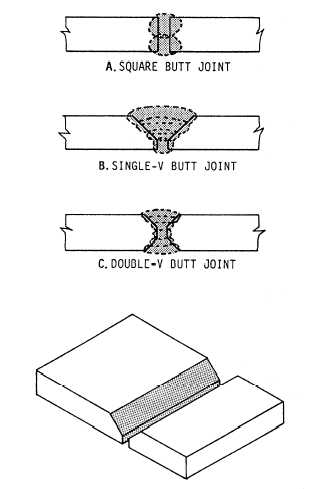
Figure 3-23. - Butt joints.
Whether the load will be in tension or compression and whether bending, fatigue, or impact stresses will be applied
How a load will be applied; that is, whether the load will be steady, sudden, or variable
The direction of the load as applied to the joint
The cost of preparing the joint
Another consideration that must be made is the ratio of the strength of the joint compared to the strength of the base metal. This ratio is called joint efficiency. An efficient joint is one that is just as strong as the base metal.
Normally, the joint design is determined by a designer or engineer and is included in the project plans and specifications. Even so, understanding the joint design for a weld enables you to produce better welds.
Earlier in this chapter, we discussed the five basic types of welded joints - butt, corner, tee, lap, and edge. While there are many variations, every joint you weld will be one of these basic types. Now, we will consider some of the variations of the welded joint designs and the efficiency of the joints.
The square butt joint is used primarily for metals that are 3/16 inch or less in thickness. The joint is reasonably strong, but its use is not recommended when the metals are subject to fatigue or impact loads. Preparation of the joint is simple, since it only requires matching the edges of the plates together; however, as with any other joint, it is important that it is fitted together correctly for the entire length of the joint. It is also important that you allow enough root opening for the joint. Figure 3-23 shows an example of this type of joint.
When you are welding metals greater than 3/16 inch in thickness, it is often necessary to use a grooved butt joint. The purpose of grooving is to give the joint the required strength. When you are using a grooved joint, it is important that the groove angle is sufficient to allow the electrode into the joint; otherwise, the weld will lack penetration and may crack. However, you also should avoid excess beveling because this wastes both weld metal and time. Depending on the thickness of the base metal, the joint is either single-grooved (grooved on one side only) or double-grooved (grooved on both sides). As a welder, you primarily use the single-V and double- V grooved joints.
The single-V butt joint (fig. 3-23, view B) is for use on plates 1/4 inch through 3/4 inch in thickness. Each member should be beveled so the included angle for the joint is approximately 60 degrees for plate and 75 degrees for pipe. Preparation of the joint requires a special beveling machine (or cutting torch), which makes it more costly than a square butt joint. It also requires more filler material than the square joint; however, the joint is stronger than the square butt joint. But, as with the square joint, it is not recommended when subjected to bending at the root of the weld.
The double-V butt joint (fig. 3-23, view C) is an excellent joint for all load conditions. Its primary use is on metals thicker than 3/4 inch but can be used on thinner plate where strength is critical. Compared to the single-V joint, preparation time is greater, but you use less filler metal because of the narrower included angle. Because of the heat produced by welding, you should alternate weld deposits, welding first on one side and then on the other side. This practice produces a more symmetrical weld and minimizes warpage.
Remember, to produce good quality welds using the groove joint, you should ensure the fit-up is consistent for the entire length of the joint, use the correct groove
Continue Reading